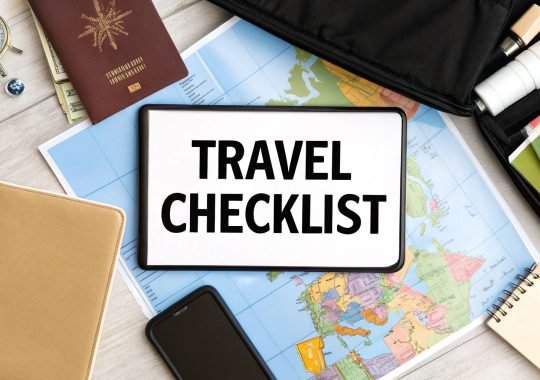Traveling solo is one of life’s most enriching experiences, offering unparalleled freedom and self-discovery. However, the key to a truly successful solo journey lies in smart, proactive preparation. This guide moves beyond generic advice to provide a comprehensive, actionable framework of solo travel safety tips. We delve into the nuanced strategies that seasoned travelers use to navigate the world safely, from digital security protocols to financial resilience.
Whether you’re planning your first solo trip or you’re a veteran explorer, these eight in-depth tips are designed to empower you, minimize risks, and maximize your adventure. Before embarking on your journey, a crucial first step is to complete Your Ultimate Emergency Preparedness Checklist, ensuring you’re ready for any unforeseen circumstances. This article will build on that foundation, covering everything from sharing your itinerary and securing documents to choosing safe accommodations and preparing for medical issues. Let’s equip you with the knowledge to travel not with fear, but with informed confidence.
1. Share Your Itinerary with Trusted Contacts
One of the most foundational solo travel safety tips is to create an external safety net before you even pack your bags. This involves meticulously sharing your detailed travel plans with a few trusted contacts, such as family members, close friends, or reliable colleagues. This isn’t just about sending a quick text with your destination; it’s about providing a comprehensive blueprint of your journey so someone always knows your intended whereabouts. This simple act ensures that if you deviate from your plan or become unreachable, someone can quickly identify the problem and initiate a response.
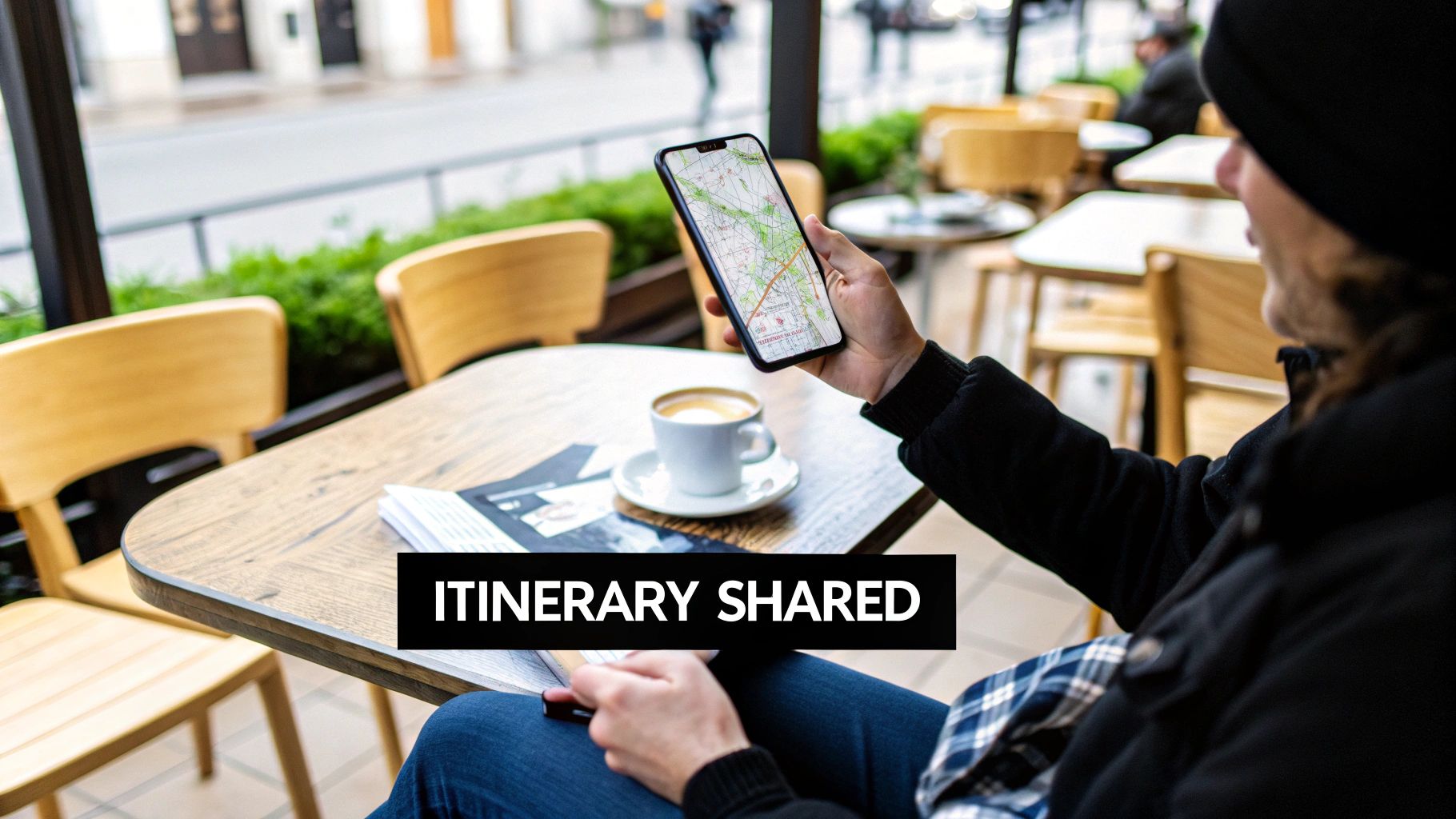
This strategy has proven lifesaving in real-world scenarios. Consider the case of adventure traveler Lisa, whose pre-shared WhatsApp live location enabled rescuers to find her swiftly after a scooter accident on a remote road in Vietnam. Similarly, when backpacker Sarah missed a scheduled check-in, her sister used the detailed itinerary to alert local authorities in Patagonia, who located her after she got lost on a hiking trail. This preemptive communication transforms your contacts into a proactive support system.
How to Effectively Share Your Plans
To implement this crucial safety measure, go beyond a simple email. Create a dynamic, easily accessible document or use dedicated apps that your contacts can reference.
- Create a Central Document: Use a shared Google Doc or spreadsheet. Include flight numbers, train schedules, accommodation addresses with phone numbers, and a rough outline of your daily activities.
- Leverage Technology: Utilize real-time location-sharing apps. Google Maps location sharing, Find My Friends on iOS, or WhatsApp’s live location feature are excellent tools. For added security, apps like bSafe offer features that can be activated in an emergency.
- Establish Check-in Protocols: Agree on a check-in schedule with your primary contact, whether it’s a quick text every morning or a call every few days. Also, designate a backup contact in case your main point person is unavailable.
- Include Local Emergency Info: Add the local equivalent of 911, the address of the nearest embassy or consulate, and a copy of your travel insurance policy to your shared document.
2. Trust Your Instincts and Situational Awareness
Beyond physical locks and shared itineraries, one of the most powerful solo travel safety tips is honing your psychological defense system: your intuition. This involves developing and trusting your instinctual sense of danger while maintaining constant awareness of your surroundings. It’s about recognizing subtle red flags, unusual behavior patterns, and potentially risky situations before they escalate. This internal alarm, often described as a “gut feeling,” is an evolutionary tool designed to keep you safe.
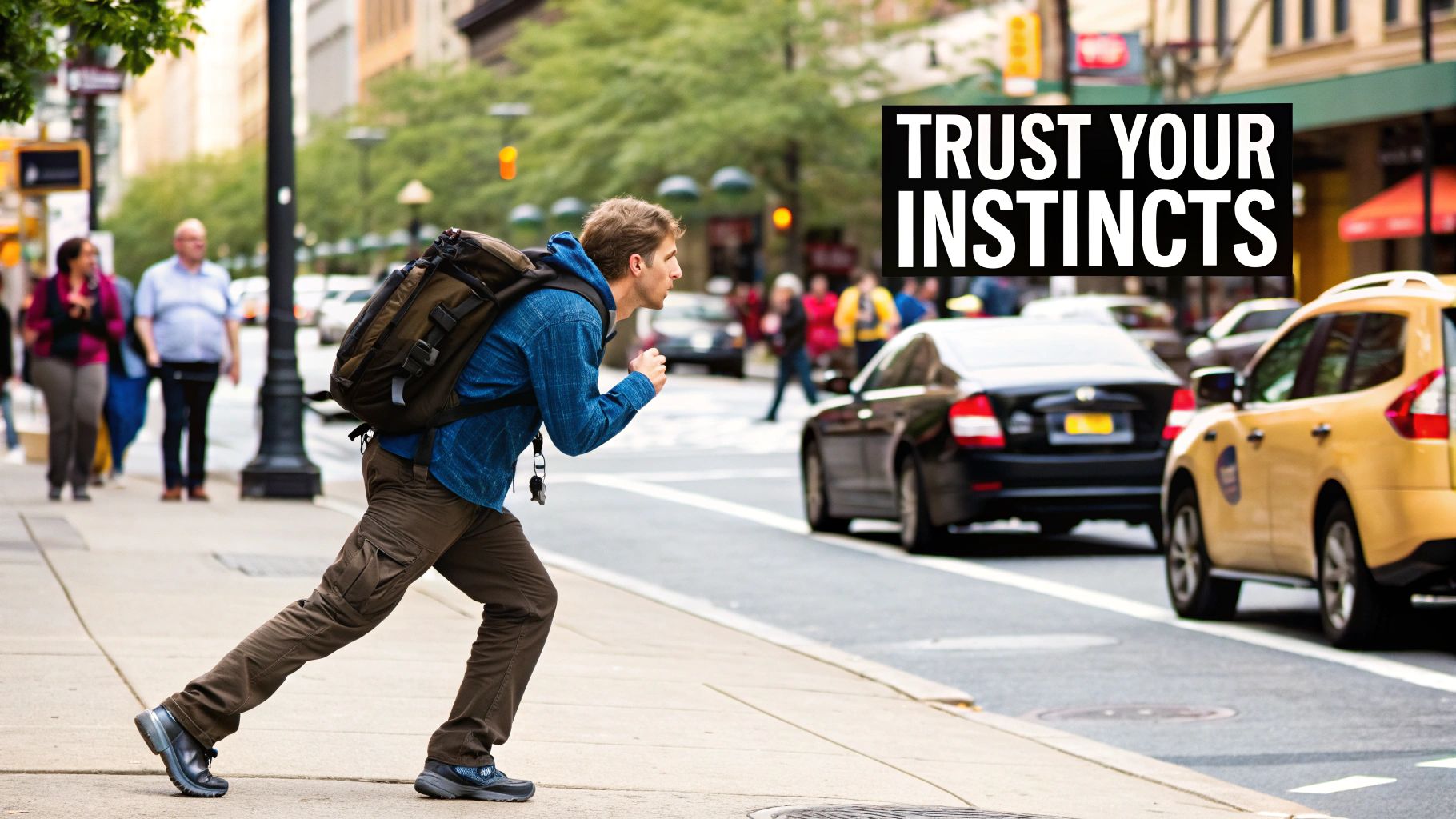
This sense of awareness is a proven asset. For instance, solo traveler Emma avoided a potential robbery in Mexico City by trusting her unease about an overly ‘helpful’ stranger and promptly walking away. Similarly, backpacker Anna left a hostel in Barcelona after the environment felt off; she later learned about recurring safety incidents there. These travelers didn’t wait for concrete proof of danger. They acted on the powerful, non-verbal signals their instincts were sending, a concept popularized by security expert Gavin de Becker in his book, “The Gift of Fear.”
How to Sharpen Your Awareness
Your intuition is a muscle that gets stronger with practice. Use these techniques to build your situational awareness and learn to trust your gut.
- Practice Active Observation: Avoid being engrossed in your phone or wearing noise-canceling headphones in unfamiliar areas. Instead, regularly scan your environment in 360 degrees, noting entry/exit points, who is around you, and the general atmosphere.
- Trust the Feeling, Not the Logic: If a person or situation makes you feel uncomfortable, don’t try to rationalize it away or worry about seeming rude. Your priority is your safety. Remove yourself from the situation immediately.
- Recognize Common Scams: Research common tourist scams and pickpocketing techniques specific to your destination. Recognizing the setup, like a staged spill or a “found” ring, helps you identify and avoid a threat before you’re entangled.
- Use the Color Code System: Practice Jeff Cooper’s tactical awareness color code. Aim to stay in “Condition Yellow” (relaxed but aware) rather than “Condition White” (unaware and unprepared), allowing you to react more quickly if a threat emerges.
3. Keep Important Documents Secure and Backed Up
Your passport, visa, and identification are your lifelines while abroad, and losing them can instantly turn an adventure into a bureaucratic nightmare. One of the most critical solo travel safety tips is implementing a robust system for securing and backing up these vital documents. This involves creating redundant copies, both physical and digital, to ensure you can prove your identity, access consular services, and facilitate replacements even if the originals are lost or stolen. A multi-layered approach to document security is your best defense against theft and accidental loss.
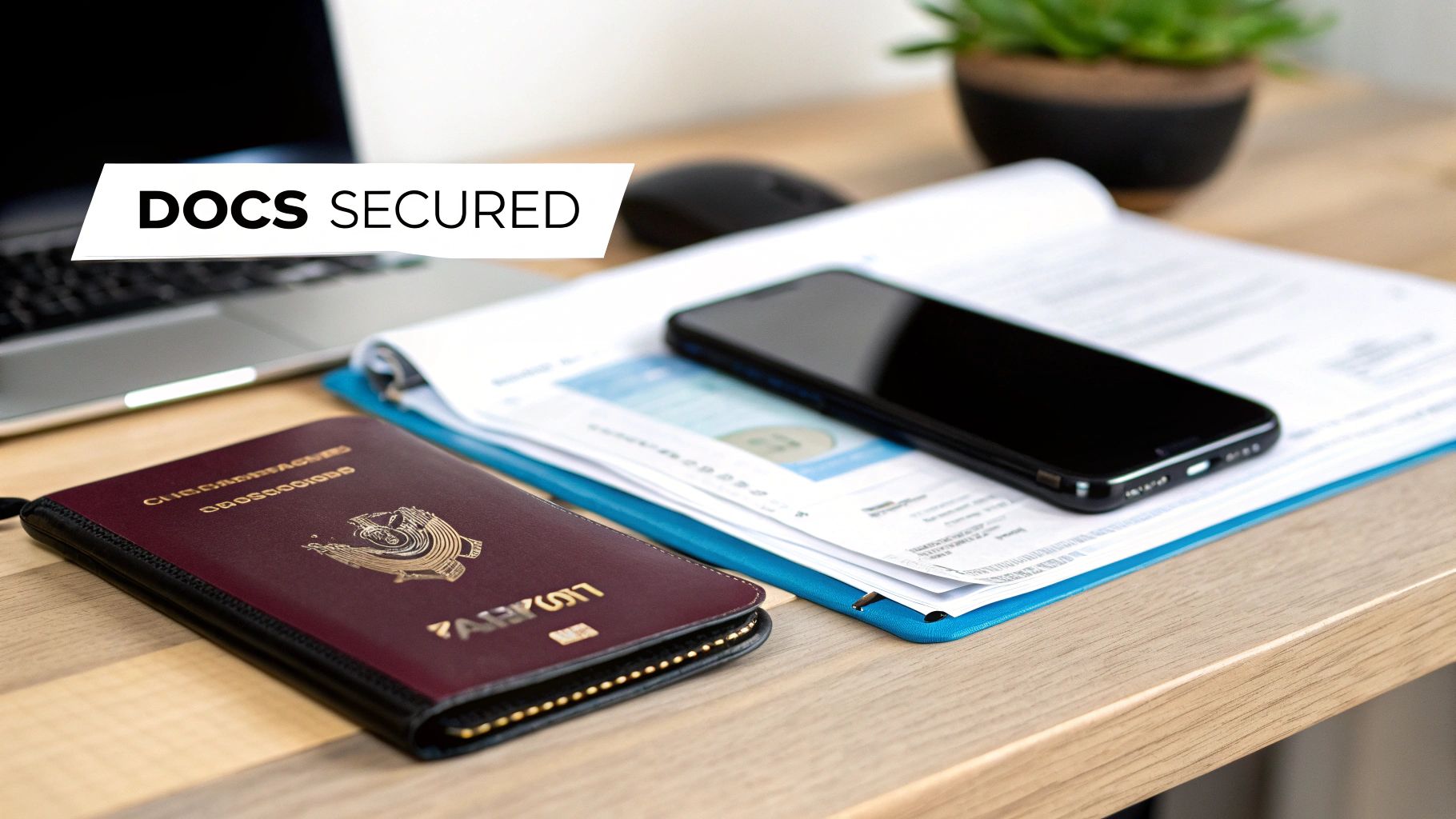
This strategy is consistently endorsed by government travel advisories and has proven invaluable in countless real-world situations. Take backpacker Tom, whose daypack containing his passport was stolen in Rome; the physical photocopies hidden in his main luggage allowed him to continue his trip with minimal disruption while awaiting an emergency travel document. Similarly, when solo traveler Rachel needed urgent medical care in Nepal, she was able to instantly access her cloud-stored insurance policy from the hospital, expediting her treatment significantly. These backups are not just conveniences; they are essential emergency tools.
How to Create a Foolproof Document System
A comprehensive backup strategy combines physical separation with secure digital storage, ensuring you’re never left without proof of identity.
- Go Digital with Cloud Storage: Scan or take clear photos of your passport, visas, driver’s license, and travel insurance policy. Upload these files to a secure cloud service like Google Drive or Dropbox. For added security, you can password-protect the folder or files.
- Physical Copies in Separate Locations: Always carry physical photocopies of your important documents. Store one set in your main luggage and another in your daypack, keeping them separate from the original documents at all times.
- Email Backups: As an additional layer, email copies of your documents to yourself and a trusted contact back home. This creates another easily accessible recovery point from any device with an internet connection.
- Register Your Trip: For international travel, register with your country’s embassy or consulate through programs like the U.S. State Department’s Smart Traveler Enrollment Program (STEP). This helps them contact you in an emergency and can streamline the process of replacing a lost or stolen passport.
4. Research Local Laws, Customs, and Scams
One of the most effective solo travel safety tips involves doing your homework before you depart. Conducting thorough pre-travel research into your destination’s legal system, cultural norms, and common tourist scams is essential for a smooth and secure trip. This preparation arms you with the knowledge to navigate a new environment confidently, helping you avoid unintentional legal trouble, cultural faux pas, and costly fraud. It allows you to blend in more seamlessly, making you a less obvious target for those looking to exploit travelers.
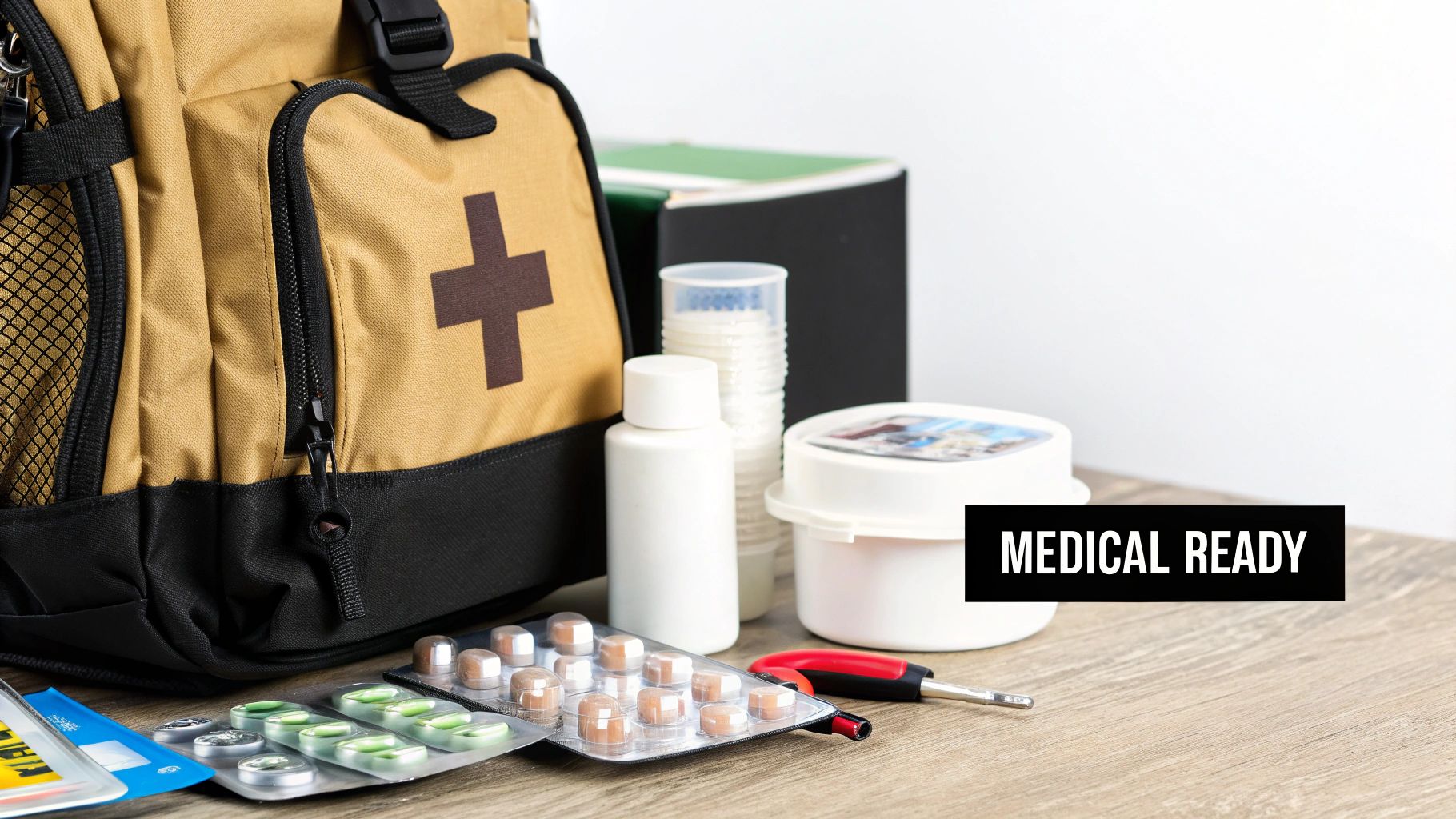
This proactive research has tangible benefits. For instance, a traveler in Germany avoided a hefty €500 fine by researching the country’s strict jaywalking laws, which are enforced much more seriously than in their home country. Similarly, a solo female traveler in Morocco confidently negotiated fair taxi fares after learning about standard rates and bargaining customs. In Paris, a backpacker instantly recognized the infamous “gold ring” scam, where a stranger “finds” a ring and pressures you to pay them for it, thanks to pre-travel research on popular schemes.
How to Effectively Research Your Destination
To arm yourself with this critical information, dive into a variety of reliable sources that offer up-to-date and practical advice.
- Check Official Government Sources: Start with your home country’s government travel advisories and the website of your embassy in the destination country. These provide crucial information on local laws, safety risks, and entry requirements.
- Consult Travel Communities: Read recent travel blogs and forums like TripAdvisor or Lonely Planet’s Thorn Tree. These platforms offer firsthand accounts and timely warnings from fellow travelers.
- Understand Cultural Norms: Research local etiquette, including appropriate dress codes (especially for religious sites), tipping customs, and social greetings. This respect for local culture can open doors to more positive interactions.
- Study Common Scams: Actively look for information on prevalent tourist scams in the specific cities you’ll be visiting. Websites like Scam Detector or travel-focused YouTube channels often have detailed breakdowns of what to watch out for.
- Note Emergency Procedures: Find and save the local emergency number (it’s not always 911), the address of the nearest consulate, and basic information about how to interact with local police.
5. Maintain Emergency Funds and Multiple Payment Methods
A critical element of solo travel safety is establishing a robust financial safety net. Financial resilience ensures that a lost wallet, a blocked card, or an unexpected emergency doesn’t derail your entire trip. This involves diversifying your payment methods, keeping a hidden emergency cash reserve, and having backup plans to access funds. By creating multiple layers of financial security, you empower yourself to handle unforeseen challenges without panic, turning a potential crisis into a manageable inconvenience.
This strategy is frequently cited as a lifesaver by seasoned travelers. For instance, when a solo traveler’s wallet was stolen in Peru, the emergency U.S. dollars hidden in her luggage allowed her to survive for three days until she could arrange for new cards. Similarly, when a backpacker’s primary debit card was unexpectedly blocked by his bank in India, his backup credit card from a different network allowed him to pay for his hostel and continue his journey seamlessly. These scenarios highlight how a lack of financial backup can quickly escalate a simple problem into a serious travel emergency.
How to Build Your Financial Safety Net
Implementing this strategy requires more than just carrying an extra credit card. It’s about creating a multi-faceted system that can withstand various points of failure.
- Diversify Your Cards: Carry at least two cards from different banking networks, such as a Visa and a Mastercard. This protects you if one network experiences an outage or isn’t accepted in a particular region. Use travel-friendly banks that have low or no foreign transaction fees.
- Create a Cash Stash: Hide an emergency fund of around $100-$200 in a widely accepted currency like USD or EUR. Split this cash between multiple secret spots in your luggage, such as inside a sock, a toiletries container, or a hidden pocket in your backpack.
- Utilize Digital Wallets: Set up Apple Pay or Google Pay on your phone. These can be invaluable if you lose your physical cards but still have your phone, as you can often use them for contactless payments.
- Inform Your Banks: Before you leave, notify your banks of your travel dates and destinations to prevent them from flagging your transactions as fraudulent. Confirm your daily withdrawal limits and have the bank’s international helpline number saved in your phone and written down elsewhere.
6. Stay Connected and Maintain Communication
A reliable communication line is your most powerful tool in any solo travel safety kit. This goes beyond just having a phone; it’s about establishing a resilient communication ecosystem that ensures you can reach out for help, contact loved ones, and access critical information, even when your primary methods fail. Having a solid plan for connectivity can be the deciding factor between a minor inconvenience and a serious emergency, allowing you to stay in control of your situation.
This strategy is a cornerstone of modern travel safety, proven effective time and again. For instance, a solo traveler’s quick-thinking purchase of a local SIM card in Bangkok enabled her to call police immediately during an attempted robbery, preventing a dangerous situation from escalating. Similarly, a backpacker who downloaded offline maps before his trip was able to navigate to safety after getting lost in rural Morocco with no internet signal. These proactive steps ensure you are never truly isolated, even when you’re alone.
How to Build Your Communication Safety Net
Implementing this strategy means preparing for a variety of scenarios, from poor signal to dead batteries. Build a multi-layered communication plan before you depart.
- Secure Local Connectivity: Upon arrival, make it a priority to get a local SIM card or activate an international roaming plan. This provides immediate access to local networks for calls and data, which is far more reliable than hunting for public WiFi in an emergency.
- Prepare for Offline Navigation: Before your trip, download offline maps of your destination using apps like Google Maps or Maps.me. This ensures you can navigate without a data connection, a common issue in remote or less-developed areas.
- Pack Power Redundancy: Always carry a fully charged portable battery pack (power bank) and all necessary charging cables. A dead phone is useless, so having a backup power source is non-negotiable for any solo traveler. Beyond having a reliable portable WiFi device, understanding how to improve cell reception can be crucial for emergency communication.
- Consider a Satellite Communicator: For travel in remote wilderness areas where cell service is nonexistent, invest in a satellite messenger like a Garmin inReach or SPOT device. These devices allow you to send emergency SOS signals and pre-set messages from anywhere on the planet.
7. Choose Safe Accommodations and Transportation
Your accommodation and transportation are two of the most critical components of your travel experience, and prioritizing their safety is a non-negotiable solo travel safety tip. A well-vetted hotel or a reliable taxi can be the difference between a secure, enjoyable trip and a situation fraught with risk. Implementing a systematic approach to selecting where you stay and how you get around means you are actively minimizing your vulnerability during moments of transition and rest, which are often when travelers are most exposed.
Real-world examples highlight the importance of this diligence. A solo female traveler in Rio de Janeiro avoided a potentially dangerous situation by cross-referencing recent hostel reviews, which revealed a sudden spike in safety concerns in an otherwise popular neighborhood. Similarly, a backpacker in Mexico City sidestepped a common taxi scam by exclusively using an official ride-sharing app, ensuring a legitimate driver and a pre-agreed fare. These choices aren’t about paranoia; they’re about making informed decisions that build a foundation of security for your journey.
How to Select Secure Lodging and Transit
A proactive strategy for vetting your choices is essential. Before you book or hail a ride, apply these practical filters to protect yourself.
- Prioritize Safety-Focused Reviews: Look past the general star rating. Scour recent reviews on platforms like Booking.com or Hostelworld for keywords like “safe,” “secure,” “solo female,” or “location.” Pay close attention to any mentions of theft, broken locks, or neighborhood safety.
- Seek Key Security Features: Opt for accommodations with a 24-hour reception, secure main entry systems (key card access), and well-lit common areas. Once in your room, immediately check that all locks on doors and windows are functional. For more comprehensive guidance, explore these additional hotel safety tips on hotelsescape.com.
- Use Official Transportation: Rely on established ride-sharing apps like Uber, Lyft, Grab, or the most trusted local equivalent. These apps provide driver details, a mapped route, and a digital payment trail, drastically reducing risks.
- Verify and Agree on Fares: If you must use a traditional taxi, only use official, marked vehicles from designated taxi stands. Before getting in, confirm the meter is working and turned on, or firmly agree on the total price to your destination to prevent disputes later.
- Consider a Portable Door Lock: For an extra layer of security and peace of mind, a simple, lightweight portable door lock or door-stop alarm is an invaluable addition to your packing list.
8. Prepare for Medical Emergencies and Health Issues
Navigating a health issue alone in a foreign country can be one of the most daunting challenges for a solo traveler. Proactive health preparation is a non-negotiable solo travel safety tip that transforms potential crises into manageable situations. This involves creating a comprehensive health strategy that covers everything from insurance and documentation to having essential medical supplies on hand, ensuring you’re equipped to handle anything from a minor illness to a serious emergency. This foresight allows you to navigate unfamiliar healthcare systems with confidence and get the care you need promptly.
Real-world examples underscore the importance of this preparation. Consider the solo traveler whose comprehensive World Nomads insurance covered a $50,000 medical evacuation after a motorcycle accident in Thailand. Or the backpacker in rural Bolivia whose personal first-aid kit was crucial for treating severe food poisoning where medical supplies were scarce. Similarly, a traveler’s medical alert bracelet communicated a diabetic condition to first responders in Japan, ensuring proper treatment despite a significant language barrier. These scenarios highlight how a small amount of planning can have life-altering outcomes.
How to Effectively Prepare for Health Issues
Implementing a robust medical plan involves several key actions that create a personal health safety net wherever you are in the world.
- Secure Comprehensive Travel Insurance: Do not leave home without it. Choose a policy that covers not only medical treatment but also, crucially, emergency medical evacuation. Read the fine print to understand coverage limits and exclusions for activities you plan to do.
- Organize Your Medical Information: Carry all prescription medications in their original containers, accompanied by a doctor’s note or a copy of the prescription. For chronic conditions, wear a medical alert bracelet or necklace. It’s also wise to create a small card with your medical conditions, allergies, and blood type translated into the local language.
- Pack a Tailored Medical Kit: Assemble a first-aid kit with essentials like bandages, antiseptic wipes, pain relievers, and antihistamines. Add personal medications and items specific to your destination, such as water purification tablets or advanced stomach remedies. A well-stocked kit also helps manage minor issues like jet lag. You can learn more about how to minimize jet lag on hotelsescape.com.
- Research Local Healthcare: Before you arrive, identify reputable hospitals or clinics near your accommodations. Note their addresses and phone numbers, and understand the local emergency number (it’s not always 911). Knowing where to go saves critical time in an emergency.
Solo Travel Safety Tips Comparison Table
| Strategy | Implementation Complexity 🔄 | Resource Requirements ⚡ | Expected Outcomes 📊 | Ideal Use Cases 💡 | Key Advantages ⭐ |
|---|---|---|---|---|---|
| Share Your Itinerary with Trusted Contacts | Medium: Requires consistent updates and internet | Moderate: Apps, devices, internet connection | High: Faster emergency response and peace of mind | Solo travelers, remote locations, high-risk activities | Immediate assistance channel; track changes |
| Trust Your Instincts and Situational Awareness | Low: No technology needed but requires practice | Low: Personal awareness and experience | Moderate to High: Early danger detection | All travelers, especially solo and urban environments | Free, adaptable, improves with experience |
| Keep Important Documents Secure and Backed Up | Medium: Organizing physical & digital backups | Moderate: Cloud storage, secure wallets | High: Quick document recovery in emergencies | All travelers needing legal/insurance proof | Reduces stress; facilitates claims and assistance |
| Research Local Laws, Customs, and Scams | Medium to High: Requires time-consuming research | Low to Moderate: Internet access and reading | Moderate: Avoids legal issues and scams | Travelers to unfamiliar destinations; culturally sensitive trips | Prevents fines/scams; enables authentic experiences |
| Maintain Emergency Funds and Multiple Payments | Medium: Managing multiple accounts and cash | Moderate: Multiple financial products | High: Ensures financial security in crises | All travelers; especially remote or long-term | Financial backup; payment diversity |
| Stay Connected and Maintain Communication | Medium: Needs devices, SIM cards, backup methods | Moderate to High: Devices, service plans | High: Immediate contact and help access | Remote areas, emergencies, prolonged trips | Reliable help access; real-time info |
| Choose Safe Accommodations and Transportation | Medium: Requires research and verification | Moderate: Time to research and possibly cost | High: Reduces risk of crime and accidents | All travelers prioritizing safety over budget | Secure base; safer transport options |
| Prepare for Medical Emergencies and Health Issues | Medium to High: Insurance, supplies, documentation | Moderate to High: Insurance, meds, kits | High: Faster medical care and lower costs | Travelers with health concerns, long trips, adventure travel | Peace of mind; emergency medical readiness |
Your Journey to Safe and Empowered Solo Travel
Embarking on a solo journey is one of the most enriching experiences you can gift yourself. It’s a powerful statement of independence, curiosity, and courage. As we’ve explored, the foundation of a truly transformative solo adventure isn’t the absence of risk, but the presence of smart, proactive preparation. Mastering the art of solo travel is a continuous process, and the comprehensive solo travel safety tips detailed in this guide are your blueprint for building confidence on the road.
True safety isn’t about wrapping yourself in a protective bubble; it’s about having the tools and the mindset to navigate the world with empowered awareness. It’s the quiet confidence that comes from knowing your documents are backed up, your emergency funds are accessible, and a trusted friend knows your whereabouts. This preparedness frees your mind from anxiety, allowing you to fully immerse yourself in the present moment, whether that’s savoring a street food delicacy, getting lost in a museum, or simply watching the world go by from a cafe.
Key Takeaways for the Savvy Solo Traveler
Let’s distill the core principles we’ve covered into actionable pillars for your travel philosophy:
- Proactive Planning is Your Superpower: The work you do before you leave is the most critical. Researching local customs, securing your accommodations, and preparing digital and physical copies of your documents are non-negotiable steps. This foresight prevents most common issues from ever arising.
- Awareness is Your Constant Companion: Your intuition is a finely tuned instrument. Learning to trust that gut feeling when a situation feels off is one of the most vital solo travel safety tips. This, combined with active situational awareness, helps you steer clear of potential threats before they escalate.
- Redundancy Creates Resilience: Never rely on a single point of failure. Have multiple payment methods, backup copies of important files, and more than one way to contact help. A lost wallet or a dead phone battery should be an inconvenience, not a full-blown crisis.
Turning Knowledge into Action
The ultimate goal of these strategies is to integrate them so seamlessly into your travel routine that they become second nature. Before your next trip, create a personal safety checklist based on the pillars we’ve discussed. Did you share your detailed itinerary? Have you downloaded offline maps? Do you know the local emergency number?
By embracing these practices, you are not just traveling; you are becoming a more capable, self-reliant, and resilient individual. You are learning to trust yourself implicitly. This journey of empowerment is the hidden reward of solo travel, a benefit that extends far beyond your return flight. Travel boldly, travel wisely, and let your adventures be defined by freedom and discovery, not fear.
Ready to find the perfect, secure home base for your next adventure? Use HotelsEscape to filter for accommodations with 24/7 reception, in-room safes, and top-rated guest reviews for safety and location. Plan your trip with confidence at HotelsEscape.


